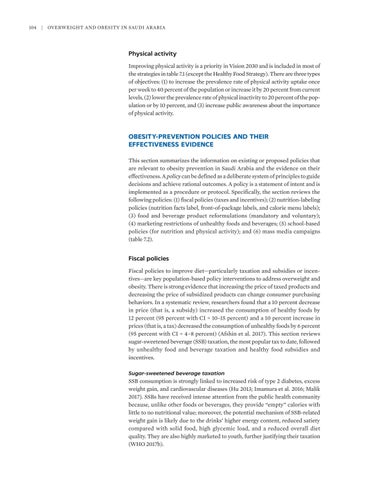104
|
Overweight and Obesity in Saudi Arabia
Physical activity Improving physical activity is a priority in Vision 2030 and is included in most of the strategies in table 7.1 (except the Healthy Food Strategy). There are three types of objectives: (1) to increase the prevalence rate of physical activity uptake once per week to 40 percent of the population or increase it by 20 percent from current levels, (2) lower the prevalence rate of physical inactivity to 20 percent of the population or by 10 percent, and (3) increase public awareness about the importance of physical activity.
OBESITY-PREVENTION POLICIES AND THEIR EFFECTIVENESS EVIDENCE This section summarizes the information on existing or proposed policies that are relevant to obesity prevention in Saudi Arabia and the evidence on their effectiveness. A policy can be defined as a deliberate system of principles to guide decisions and achieve rational outcomes. A policy is a statement of intent and is implemented as a procedure or protocol. Specifically, the section reviews the following policies: (1) fiscal policies (taxes and incentives); (2) nutrition-labeling policies (nutrition facts label, front-of-package labels, and calorie menu labels); (3) food and beverage product reformulations (mandatory and voluntary); (4) marketing restrictions of unhealthy foods and beverages; (5) school-based policies (for nutrition and physical activity); and (6) mass media campaigns (table 7.2).
Fiscal policies Fiscal policies to improve diet—particularly taxation and subsidies or incentives—are key population-based policy interventions to address overweight and obesity. There is strong evidence that increasing the price of taxed products and decreasing the price of subsidized products can change consumer purchasing behaviors. In a systematic review, researchers found that a 10 percent decrease in price (that is, a subsidy) increased the consumption of healthy foods by 12 percent (95 percent with CI = 10–15 percent) and a 10 percent increase in prices (that is, a tax) decreased the consumption of unhealthy foods by 6 percent (95 percent with CI = 4–8 percent) (Afshin et al. 2017). This section reviews sugar-sweetened beverage (SSB) taxation, the most popular tax to date, followed by unhealthy food and beverage taxation and healthy food subsidies and incentives. Sugar-sweetened beverage taxation
SSB consumption is strongly linked to increased risk of type 2 diabetes, excess weight gain, and cardiovascular diseases (Hu 2013; Imamura et al. 2016; Malik 2017). SSBs have received intense attention from the public health community because, unlike other foods or beverages, they provide “empty” calories with little to no nutritional value; moreover, the potential mechanism of SSB-related weight gain is likely due to the drinks’ higher energy content, reduced satiety compared with solid food, high glycemic load, and a reduced overall diet quality. They are also highly marketed to youth, further justifying their taxation (WHO 2017b).






